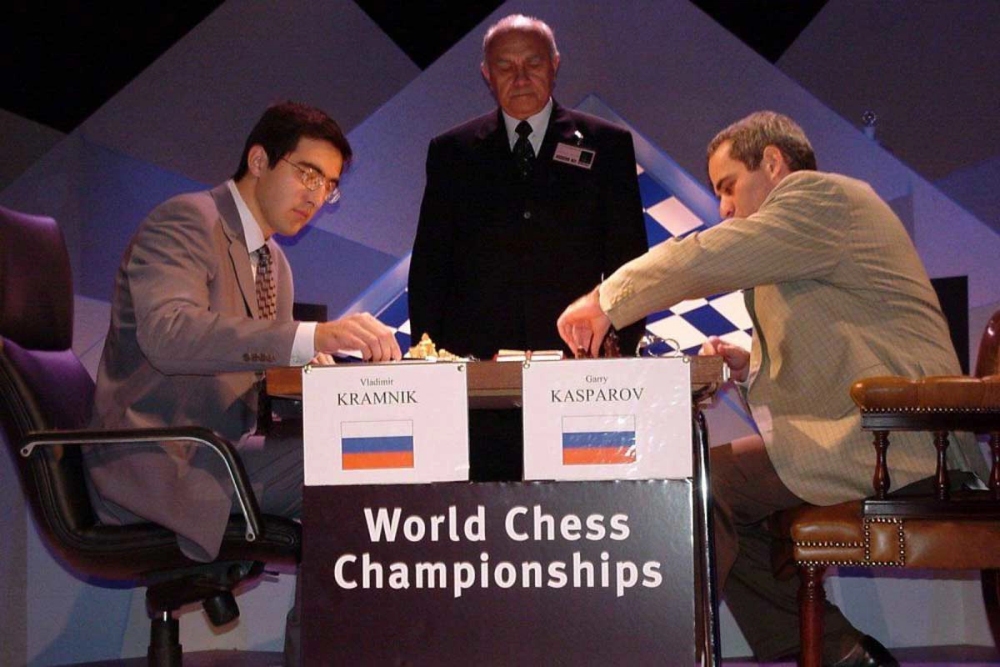Twenty-five years ago, in London, the World Championship match between Garry Kasparov and Vladimir Kramnik took place. Kasparov had been world champion for 15 years, dominated the world rankings, and was the clear favourite. But things turned out differently.
The Background
Kasparov had needed two championship matches to dethrone Anatoly Karpov. Their first encounter, in 1984, was abandoned after 48 games with Karpov leading 5–3, as neither player seemed likely to score the required sixth win under the match rules of the time. A player still needed six victories to claim the title — a regulation dating back to the 19th century.
Kasparov won the rematch under revised rules, but had to defend his title against Karpov three more times in the following years. The deposed champion was entitled to a rematch in 1986, and he later requalified as challenger in 1987 and 1990.
Frustrated by the special privileges granted to Karpov by the FIDE leadership — and blaming then–FIDE president Florencio Campomanes — Kasparov broke away from the federation. When new challenger Nigel Short proposed in 1993 to stage the World Championship independently, Kasparov readily agreed.
Together they founded the Professional Chess Association (PCA). The Times of London became the main sponsor of the Kasparov–Short match, which Kasparov won convincingly.
The PCA then organised another full qualification cycle in competition with FIDE, from which Viswanathan Anand emerged as challenger. Kasparov won that match as well, played in 1995 at New York’s World Trade Center. But the PCA soon ran out of money and organisational strength. It would take five more years before Kasparov’s organisation could stage another World Championship match.
As the “classical” world champion — but no longer recognised by FIDE — Kasparov had to defend his legitimacy even while remaining the undisputed number one in the world. The chess world expected him to defend his title against a worthy opponent. By 1997–1998, Anand and Kramnik were the two leading contenders. Anand was offered the match first but declined. Kramnik was next in line.
To lend the process at least a semblance of qualification, a match between Kramnik and Alexei Shirov was arranged. Shirov, who had finished second behind Anand at the 1998 Linares supertournament (ahead of both Kasparov and Kramnik), won the playoff. However, financial backing for the planned Kasparov–Shirov match collapsed. Shirov rejected a reduced prize offer, and Kramnik — as a substitute — ended up receiving the opportunity instead.
The Organisation
The match was organised by Braingames, a company founded specifically for the event by Raymond Keene. He secured several investors, apparently promising profits from live Internet broadcasting — a novelty at the time. For the first time in chess history, a world championship match was to be shown live online. Fans around the world could register on the Braingames website for a fee and gain access to the broadcast.
Raymond Keene 2023 | Photo: Archive Frederic Friedel
The idea of financing part of the match through online subscriptions, however, proved illusory. Journalists in the press room relayed the moves almost in real time via text messages, and British newspapers soon began posting the moves on their own websites for free. Braingames filed suit but lost; the court ruled that chess moves were comparable to sports results and therefore could not be copyrighted.
The Players’ Preparation
Kramnik assembled a small but highly focused team of seconds: Sergey Dolmatov, Evgeny Bareev, Miguel Illescas, and Joel Lautier. Each was assigned a specific opening area to prepare for match play. Bareev and Dolmatov worked on Kramnik’s White repertoire, except for the Grünfeld Defence — Kasparov’s main weapon against 1.d4 — which was handled by Illescas. Lautier and Kramnik prepared the Scotch Game from the Black side. Lautier, one of the few players with a positive score against Kasparov, also suggested reviving the long-forgotten Berlin Defence to the Ruy Lopez.
Kramnik had also improved his physical fitness before the match: he quit smoking, changed his diet, and trained intensively, especially swimming. A sports physiologist assisted him.
Kasparov, by contrast, relied on his proven partnership with long-time trainer Yuri Dokhoian.
The Setting
The venue was the Riverside Studios in Hammersmith, on the north bank of the Thames. Originally built as film studios, the BBC used them after the war for television production. In the 1980s, they once again served as film studios, then as a theatre, later as a cinema.
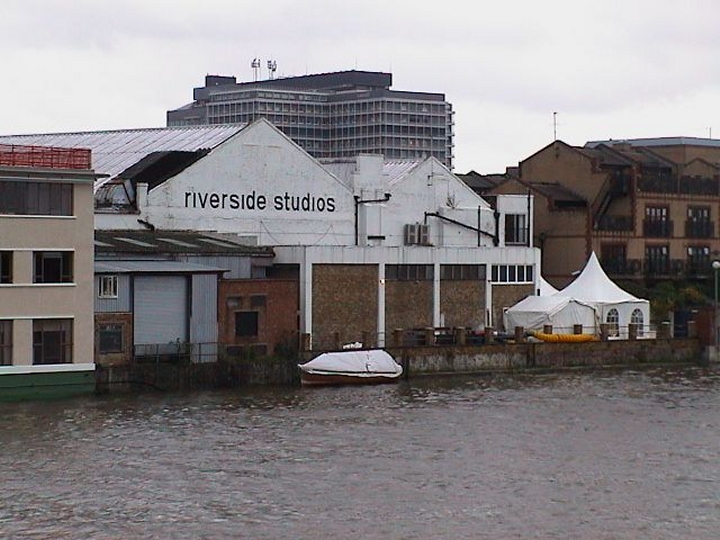
Photo: Ben Bartels
The Match
The World Championship took place from 8 October to 4 November and was limited to 16 games. In the event of a tie, the reigning champion would retain his title. The prize fund was two million dollars, with two-thirds going to the winner.
Kasparov, long accustomed to victory, entered as the heavy favourite. Between 1985 and 1995 he had won every title match he played, while Kramnik had shown weakness in previous matches — losing to Shirov and struggling in earlier Candidates events. The two knew each other well: Kasparov, 37 at the time, had mentored the 13-years-younger Kramnik since his teens. It was Kasparov who had arranged for the 17-year-old Kramnik to play for the Russian national team in 1992, and Kramnik had later served as Kasparov’s second in several matches. Kasparov regarded him as a natural successor — though surely not one to replace him just yet.
The Course of the Match
The match quickly turned against the champion. Kasparov began with White but was surprised by Kramnik’s choice of the then rarely used Berlin Defence to the Ruy Lopez. The main line leads to an early queen exchange and a quiet, strategic middlegame. Kramnik’s choice effectively neutralised two of Kasparov’s strengths: his direct attacking style and his deep computer-assisted preparation, which was less effective in such uncharted, long-term positions. The first game was drawn after 25 moves.
In the second game, things went even worse. With Black, Kasparov entered his beloved Grünfeld Defence, but again an early queen trade led to an unfavourable endgame. He could not hold it and Kramnik took the lead.
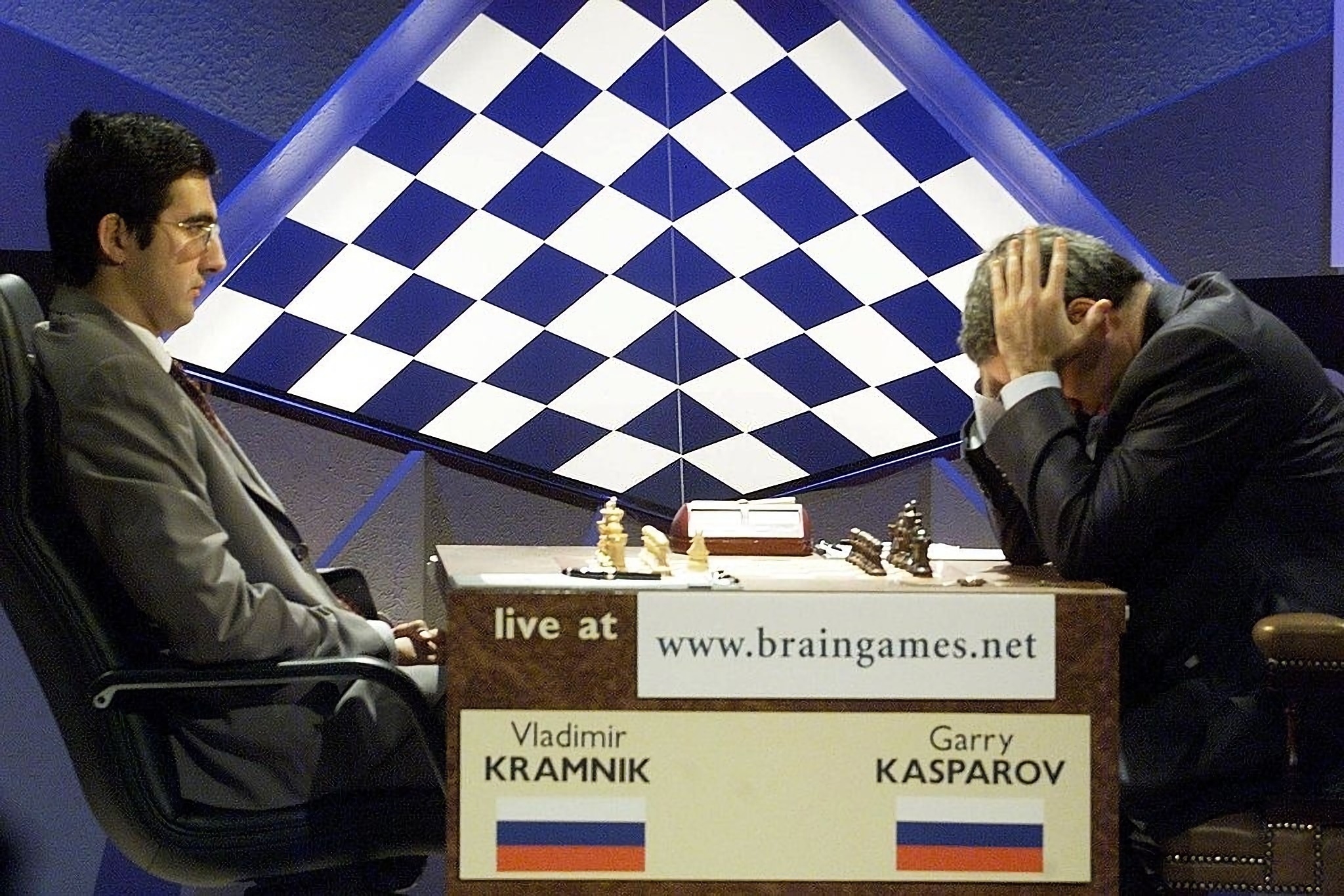
Photo: Ben Bartels
After two games, Kramnik led 1½–½. Kasparov and his team now faced two problems: how to gain an advantage with White against the Berlin, and how to repair the Grünfeld Defence. In fact, Kasparov never used the Grünfeld again in this match.
Game three again featured the Berlin Defence. Kasparov fought harder this time but found himself in difficulties and escaped with a draw only thanks to some luck.
In game four, Kasparov had Black again and switched to the Queen’s Gambit Accepted. Once more Kramnik exchanged queens early and pressed Kasparov positionally. The champion was again on the defensive, a pawn down in the endgame, and fortunate to draw after Kramnik missed winning continuations.
In game five, Kasparov opened with 1.c4, signalling that he still lacked a solution to the Berlin. He obtained some pressure for the first time but could not maintain it and accepted Kramnik’s draw offer after only 24 moves.
In game six, Kasparov again found himself under pressure in the Queen’s Gambit Accepted and was forced to defend a poor position for a long time. Once more, fortune favoured him: Kramnik missed a win in a nearly decisive position.
In game seven, Kasparov, apparently exhausted, offered a draw with White after only eleven moves in an English Opening. It was clear that the champion was nervous.
After his poor results with the Queen’s Gambit Accepted, Kasparov switched to the Nimzo-Indian Defence in game eight and achieved a promising position, but no more than a draw.
At the halfway point, the momentum was with Kramnik. He led by one win and had been the more dominant player throughout. With more consistent play, the score might already have been 3–0.
In game nine, Kasparov again faced the Berlin but found nothing new. If he had prepared any surprise, it came to nothing.
Game ten brought the decisive blow. Playing the Nimzo-Indian once more, Kasparov was caught off guard by a prepared piece sacrifice — an idea Boris Gelfand had mentioned to Kramnik before the match. Objectively the sacrifice gave no advantage, but Kasparov, less at home in the Nimzo-Indian than in the Grünfeld, failed to find the best replies. Kramnik converted and extended his lead to 2–0.
Kasparov now needed two wins in the remaining six games just to draw level and retain his title. But he never came close. In game eleven, Kramnik abandoned the Berlin for the Arkhangelsk Variation, but Kasparov could not convert a technically complex endgame.
The twelfth game saw another Nimzo-Indian; Kasparov obtained an advantage with Black but lost it in time trouble.
Kasparov still had four games left to play. The feeling of having to win was not new to him; he had experienced it during the 1987 World Championship match against Karpov. Back then, he had lost the 23rd game and needed to win the 24th, the final one, to draw the match and retain his title. Kasparov managed it then. But thirteen years had passed since that triumph.
In the 13th game, Kasparov had White again but again found no recipe against the Berlin and offered a draw after only 14 moves.
In the next game, game 14, Kramnik went for the English and played 1.c4. Against Kasparov’s Hedgehog he gained some space advantage and then chose to simplify, sacrificing a pawn to reach a rook endgame with a pawn down but good drawing chances. Kasparov pressed for the win, but Kramnik held the endgame.
In his final game with the white pieces, Kasparov finally abandoned the opening move 1.e4 and for the first time opened with the queen’s pawn. In a Catalan he obtained a slight space advantage but no real winning chances. On move 38 he gave up his efforts to win and accepted a draw. And that was it.
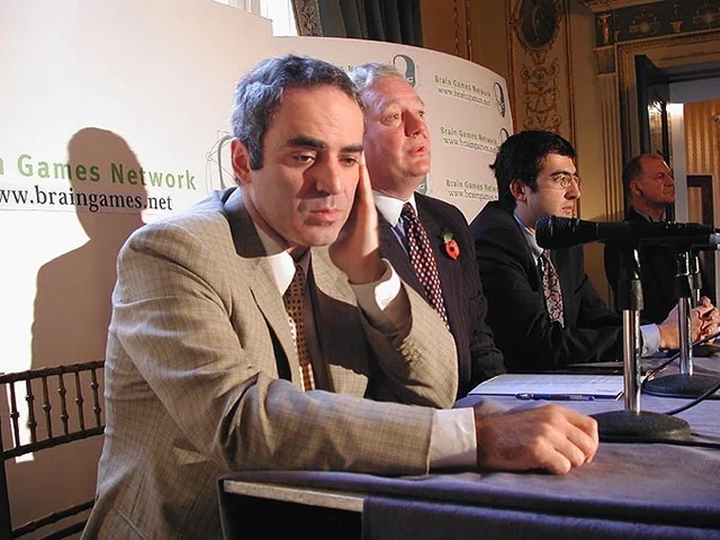
A disappointed Kasparov | Photo: Ben Bartels
After the match, Kasparov admitted that he had been outprepared by Kramnik’s team. During the match, however, he had been unable to bring himself to deviate from his repertoire or choose fresh openings simply for the sake of playing.
The End of an Era
With this defeat, an era came to an end. For 15 years Kasparov had been world champion and the number one player in the world. Yet by staging his 1993 match against Nigel Short outside FIDE, he had also split the chess world. Alongside the “classical” World Championship, FIDE was now running its own knockout world championships. The right to a rematch no longer existed. After losing the title match to Kramnik, Kasparov tried for some time to re-enter the reunification talks as a candidate, but nothing came of it.
On this DVD a team of experts gets to the bottom of Kasparov’s play. In over 8 hours of video running time the authors Rogozenko, Marin, Reeh and Müller cast light on four important aspects of Kasparov’s play: opening, strategy, tactics and endgame.
In 2005, after the Linares tournament, Kasparov — world number one by rating for twenty years — retired from competitive chess and turned increasingly to politics in Russia.
After Vladimir Putin’s crackdown on democratic movements, and the deaths of several of Kasparov’s associates, he left Russia and began commenting on events from abroad.
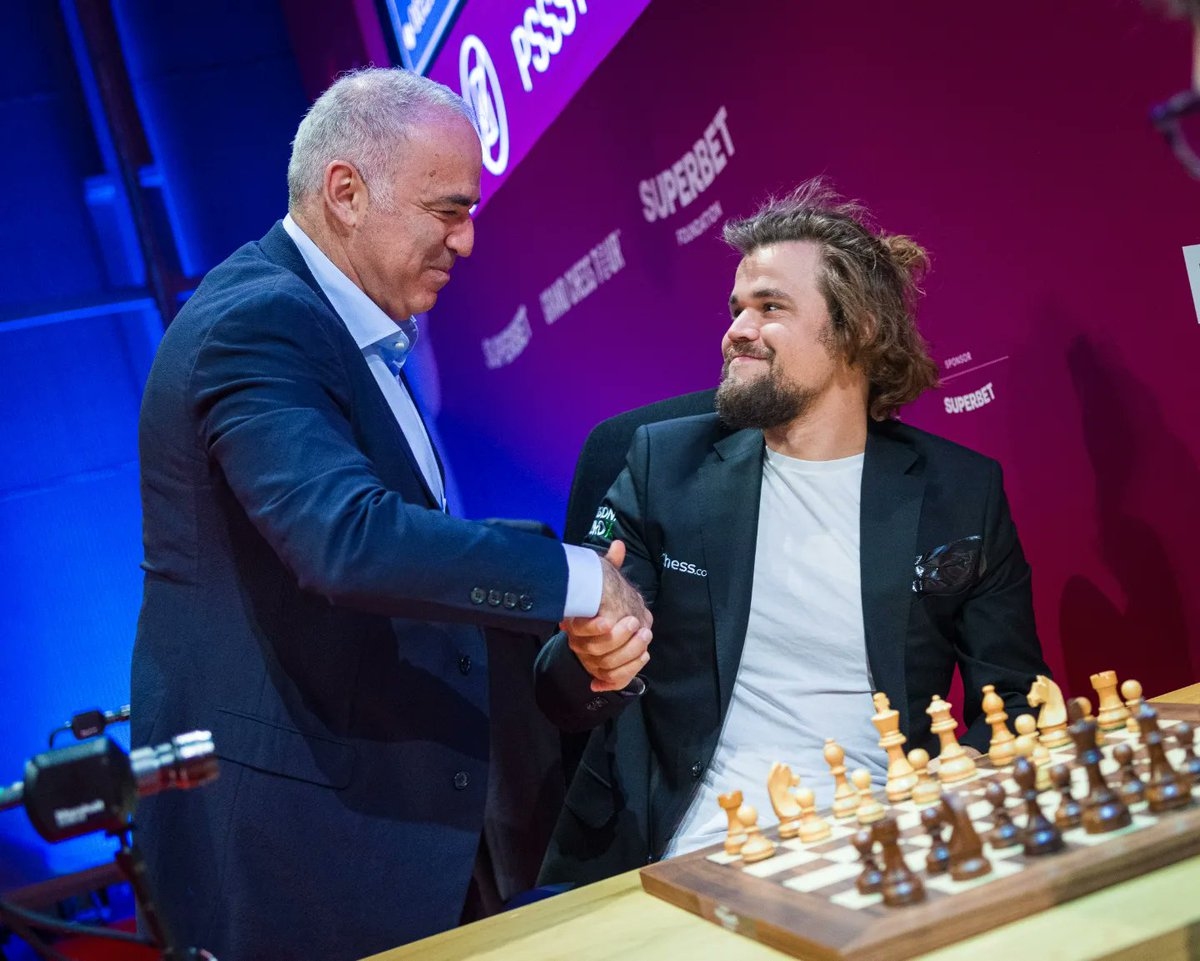
Kasparov and Carlsen | Photo: Grand Chess Tour
As part of the Grand Chess Tour, Kasparov is now active as an organiser and ambassador for the game. Through his Kasparov Chess Foundation, he also supports young chess talents from around the world. He has never entirely let go of chess: recently, in Saint Louis, he once again defeated Anand — this time in a Chess 960 match.
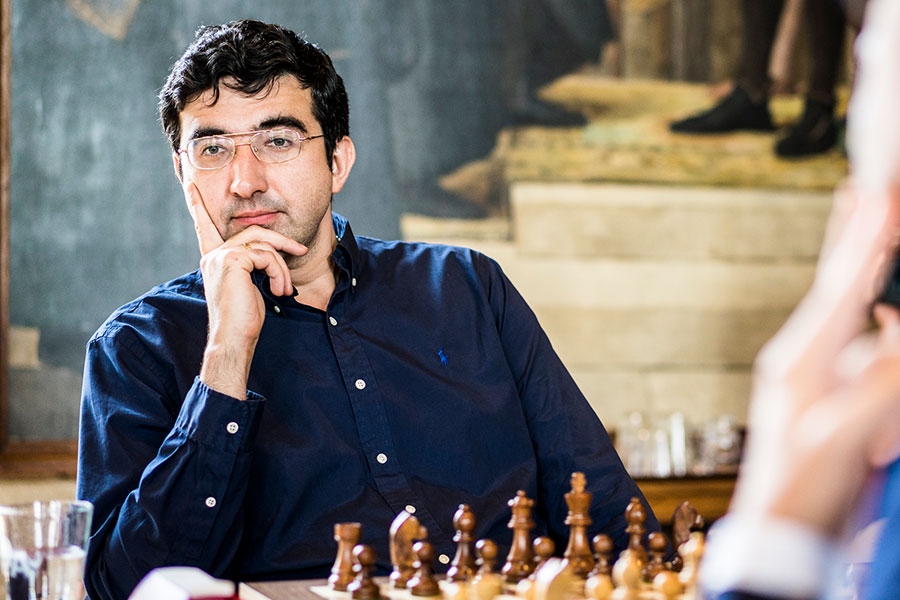
Vladimir Kramnik | Photo: Lennart Ootes
This DVD allows you to learn from the example of one of the best players in the history of chess and from the explanations of the authors (Pelletier, Marin, Müller and Reeh) how to successfully organise your games strategically, consequently how to keep y
With Vladimir Kramnik as the 14th world champion, the two rival world championship systems were eventually brought back together. His match against FIDE world champion Veselin Topalov, however, went down in chess history as “Toiletgate.” In 2007 Kramnik lost the world title to Anand in a tournament and was also defeated in the 2008 rematch in Bonn.
Today, Vladimir Kramnik no longer plays over-the-board tournament chess but still takes part in online events. He has been outspoken in criticising the growing potential for cheating with computer assistance.
All 15 games of the match
